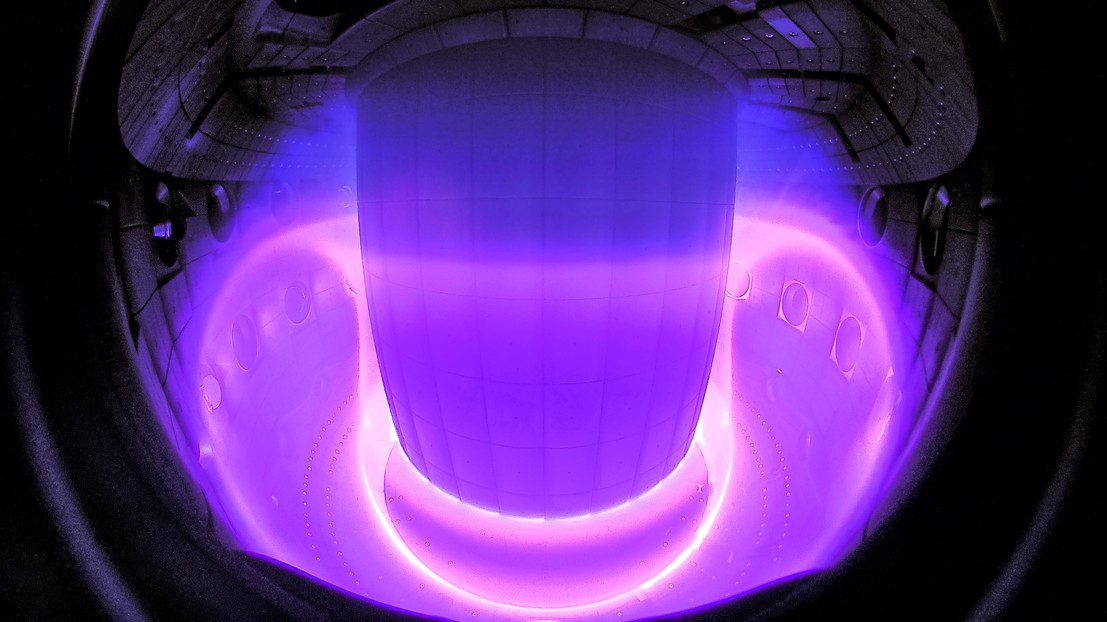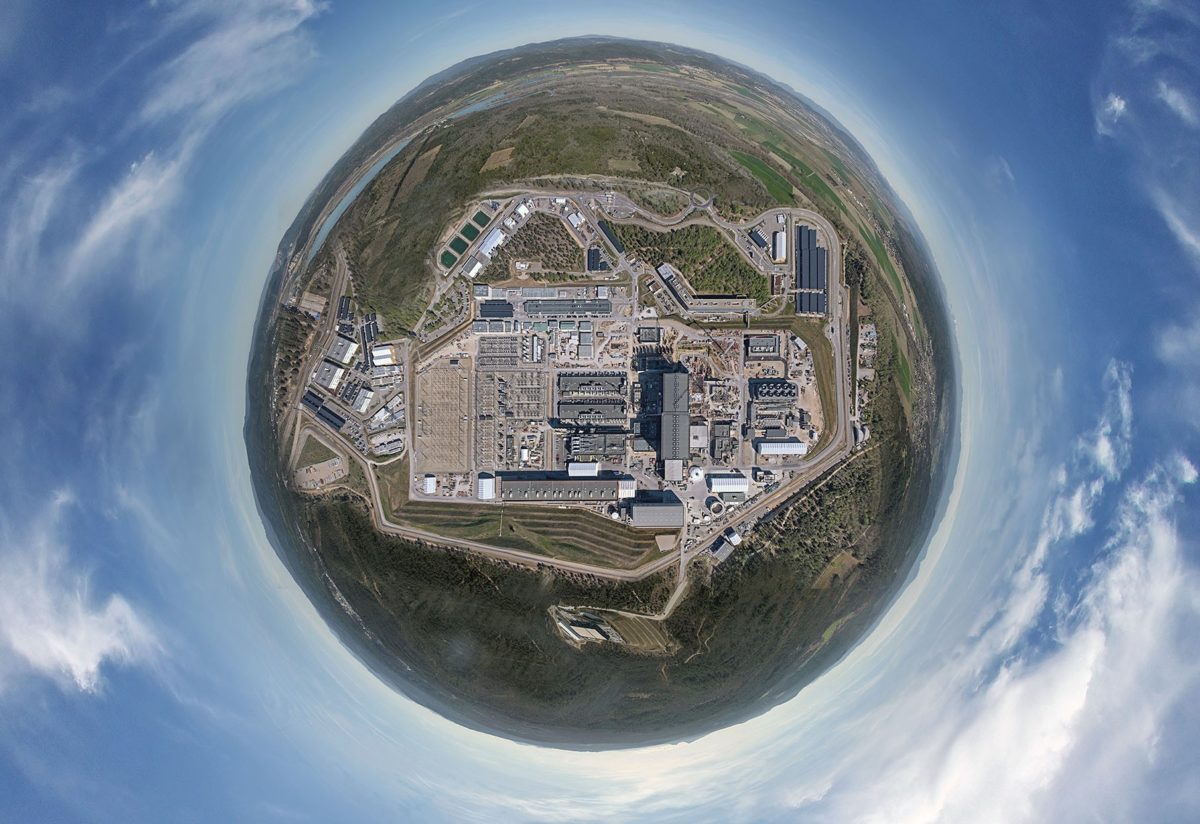The intense heat and pressure inside stars, such as the Sun, cause pairs of atoms, especially hydrogen atoms, to come together or ‘fuse’. When these light nuclei merge into a heavier nucleus, some mass gets lost and is converted into a massive amount of energy, following Einstein’s famous formula, E=mc2. This fusion process is what powers stars and releases an incredible amount of energy into the universe.
Scientists are already able to produce nuclear fusion reactions on Earth. The current challenge faced by researchers around the world is to sustain these fusion reactions continuously and harness the energy released in an efficient and controlled manner to generate more electricity than has been used to heat the machine. At EPFL, the engineers have chosen to study a method that involves using a torus-shaped magnetic confinement reactor, called a tokamak. In this approach, deuterium gas, a hydrogen isotope, is heated to 100 million degrees Celsius to transform it into a plasma – the fourth state of matter, in which electrons and nuclei are separated to form a “soup” of charged particles – and induce highly energetic collisions between the deuterium nuclei. The tokamak’s magnetic fields suspend the plasma in the middle of the vacuum chamber and away from the interior wall of the device.
- The slow race to crack nuclear fusion
- Toward an energy-secure future
- An Apollo-style program for nuclear fusion?
- What are the next steps?
The Swiss Plasma Center, now with a staff of about 200 researchers, technicians and students, started up its own tokamak 30 years ago. Owing to its unique design, this experimental reactor, called TCV for “Tokamak à configuration variable”, has become one of the most important nuclear-fusion research facilities in Europe.
“We built the reactor even before there was the internet, and its core is still the same,” says Basil Duval, a senior scientist working on the tokamak’s measurement systems. He points out that the research being carried out at the Swiss Plasma Center is known internationally – partly because of its contribution to the International Thermonuclear Experimental Reactor (ITER) project, and partly because the findings are of value to the entire nuclear-fusion research community. The Center’s scientists have published hundreds of journal articles over the years, contributing to the literature on plasma. “For a country the size of Switzerland to have an experimental facility of this caliber is really outstanding,” says Duval. The Center has also put together an MOOC on nuclear fusion, which has been taken by 45,000 people.
“We currently have around 50 PhD students working with us at any given time, and just about all of them are helping to develop new a system for measuring and controlling plasma flows,” says Yves Martin, the Center’s deputy director.
To commemorate the 30th anniversary of its tokamak, the Swiss Plasma Center hosted in September representatives of the EUROfusion consortium in September. This consortium is behind a number of nuclear-fusion initiatives, including advancing the ITER physics basis and optimizing its chances of success via experimentation on facilities such as the TCV tokamak. Ambrogio Fasoli, director of the Swiss Plasma Center, is also the chair of EUROfusion and has just been named the consortium’s programme manager. “Our work at the Swiss Plasma Center over the past 30 years has provided key insights into plasma behavior. The TCV plays a vital role in this endeavor. Recent upgrades to its infrastructure have expanded our capability to investigate key issues for ITER, DEMO, and future fusion reactors. The challenges ahead are substantial, but we are well-positioned to make significant contributions to the development of fusion energy as a critical component of the future global energy mix,” he says.
We built the reactor even before there was the internet, and its core is still the same”
A unique approach
Because EPFL’s tokamak is a “variable configuration” reactor, scientists can use it to observe how changes in plasma configuration affect the plasma’s properties (like temperature and confinement quality) and study new plasma configurations. It can also be used to evaluate different configurations for divertors, the devices used to control the release of energy from the reactor core. Their role is essential for being able to sustain plasma for long periods without damaging the reactor, and engineers are still working to optimize their design. The Swiss Plasma Center recently teamed up with Google DeepMind to develop a new magnetic control method for plasmas, based on deep reinforcement learning, and successfully applied it to real-world plasma configurations in the TCV tokamak for the first time.
Like all tokamaks, the EPFL’s tokamak features a toroidal (donut-shaped) vacuum chamber where gas is transformed into plasma. This chamber is encompassed by magnetic fields, created by large magnetic coils, that prevent the plasma from touching the interior wall of the chamber. Additionally, there is a central column with ohmic coils that inject electricity into the plasma to maintain its stability, and a poloidal field that shapes the plasma configuration. The entire reactor is outfitted with a heating system that utilizes microwaves and hot-particle injection, complemented by a comprehensive array of instruments that measure temperature, density, radiation, fluctuations in plasma configuration, and other vital parameters.
In future fusion power plants, the heat generated by fusion reactions within the plasma will power turbines-similar to current nuclear fission reactors-and produce substantial amounts of dependable baseload electricity. This process will be sustainable and carbon-free, without generating long-lasting radioactive waste.
Now, amid the energy crisis and alarm bells on climate change, interest in nuclear fusion is once again gaining ground, with dozens of startups having entered the race alongside state-backed research institutions. In the past few years alone, these firms have raised a combined $6 billion to build prototype reactors.
At EPFL, R&D is focused on vast magnetic confinement reactors like the one currently being built at the Cadarache research center in southern France as part of the ITER project, a joint initiative with the European Union and other international organizations. Inside these ultra-large reactors, plasma containing two hydrogen isotopes – deuterium and tritium – is heated to 150 million degrees Celsius, the temperature required for nuclei to collide with sufficient force to fuse. And there’s another challenge: although this scorching-hot plasma weighs just a few grams, it can cause untold damage if it touches the reactor walls.
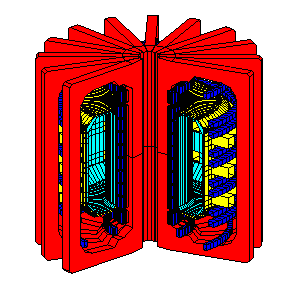
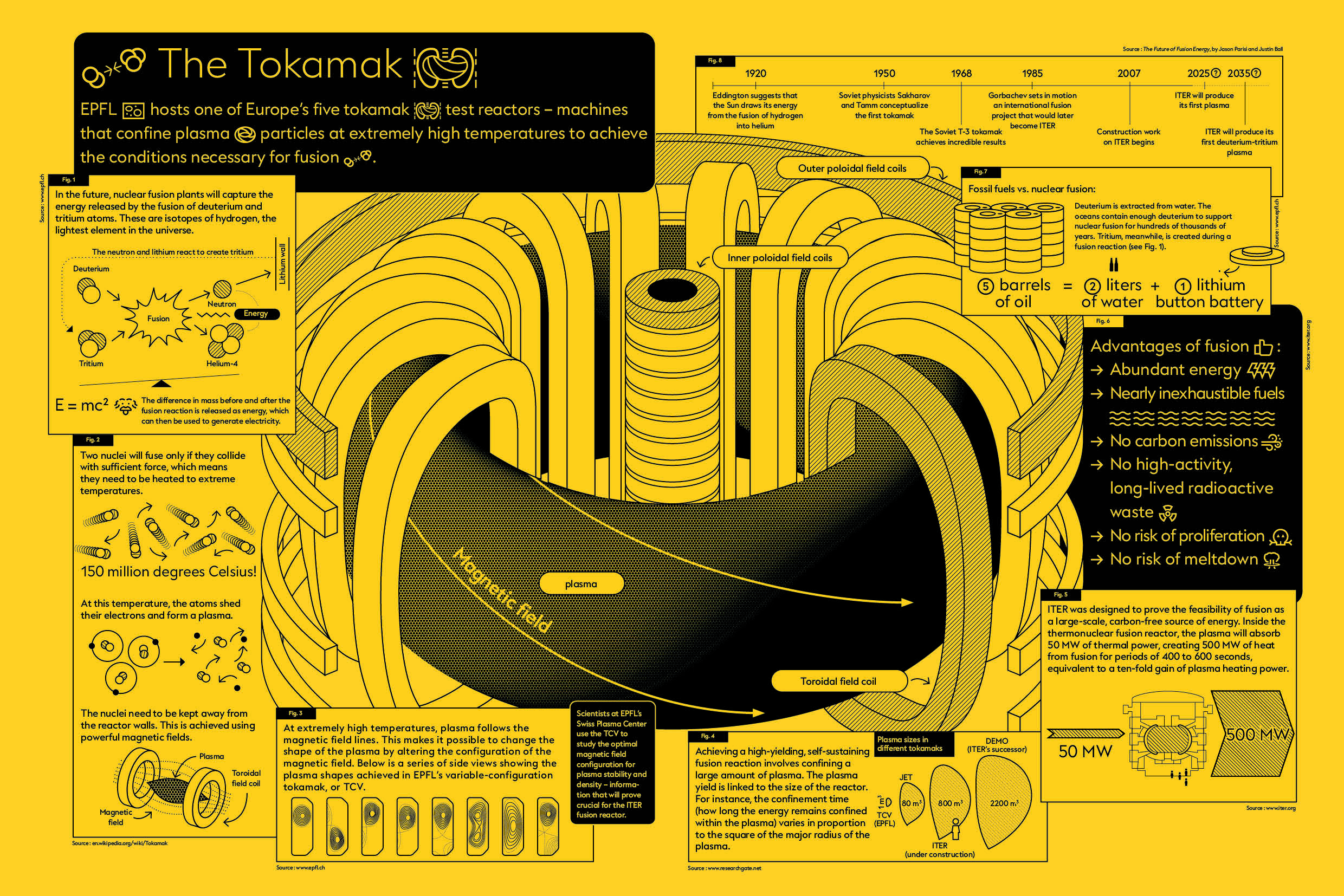
EPFL’s tokamak is a “variable configuration” reactor, meaning engineers can adjust the electromagnets surrounding its core and observe how changes in plasma configuration affect the plasma’s properties (like temperature and confinement quality). It can also be used to evaluate different configurations for divertors, the devices used to control the release of energy from the plasma. Their role is essential for being able to store plasma for long periods.
The Swiss Plasma Center recently teamed up with Google DeepMind to explore how deep learning and artificial intelligence could be applied to improve plasma configurations in real time.
Nuclear fission still plays a vital role in our energy mix because the reactors can operate continuously in the background. But this form of energy struggles to gain the support of policymakers and the general public, due in large part to safety concerns and the fact that it generates long-lived radioactive waste. Uranium supply is another headache, since the heavy metal is mined in parts of the world frequently affected by conflict.
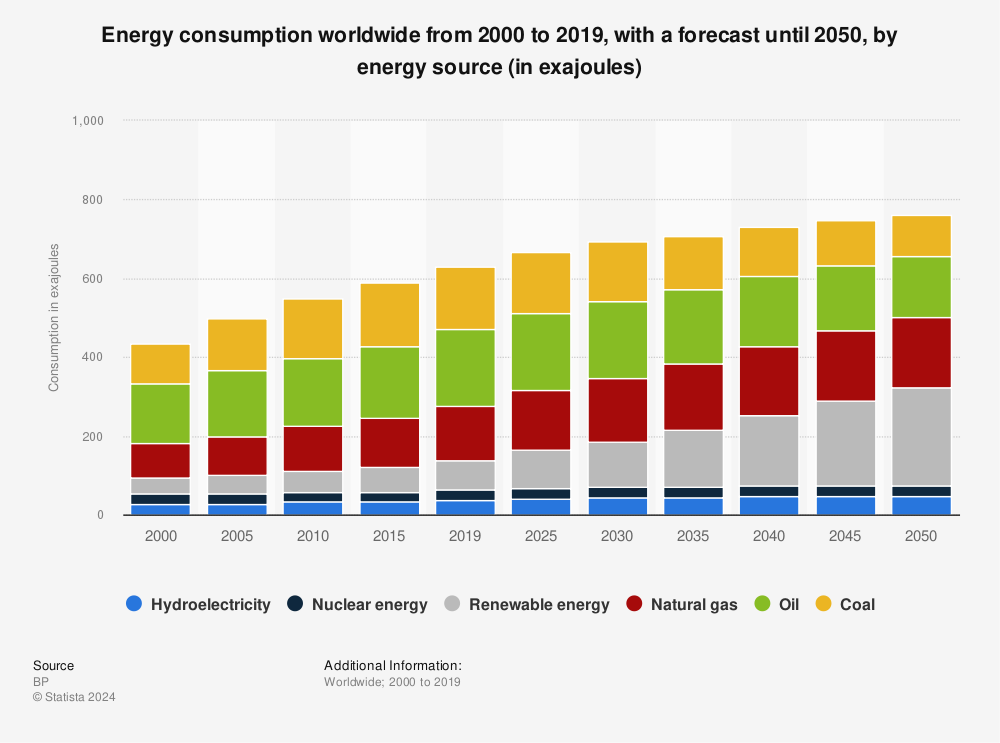
© Statista
Nuclear fusion, by its very nature, has none of these drawbacks:
It produces no long-lived waste. A nuclear fusion reaction requires just deuterium and tritium, the latter of which is radioactive only briefly and at a very low level. And although the reaction causes some tokamak parts to become radioactive, this radioactivity is short-lived (a half-life of 10–20 years, compared with hundreds of millions of years for uranium).
There’s no risk of meltdown. Inside a tokamak, the reaction stops as soon the fuel supply is cut off.
The raw materials are cheap and abundant. Deuterium is commonly found in sea water, while tritium can be made from a small amount of lithium. Per kilogram of fuel, fusion generates four million times more energy than burning oil or coal.
Harnessing nuclear fusion would therefore allow us to completely wean our society off fossil fuels. And we need to make this happen as quickly as possible.
To outsiders, the race to crack nuclear fusion may seem to be advancing at a snail’s pace. But there are good reasons for this plodding tempo: the engineering challenges are immense, and the investment required is eye-watering. ITER is a case in point. The project kicked-off in 2008 with an initial budget of €10 billion and the tokamak was supposed to produce its first plasma in 2016. But delays and cost overruns have pushed the target date back to 2028 to 2030, while the total cost will likely be way much higher than the initial budget.
Yet the findings from ITER will be decisive for the next steps in the development of nuclear fusion: the DEMO and PROTO reactors, which will be the first to feed power into the grid. “Funding shortages mean that R&D in this field is essentially progressing on a single track,” says Basil Duval, a senior scientist at the Swiss Plasma Center. “But if you look at other large-scale R&D programs like Apollo, they were successful because several research groups worked on them in parallel, and only the best technology was chosen.”
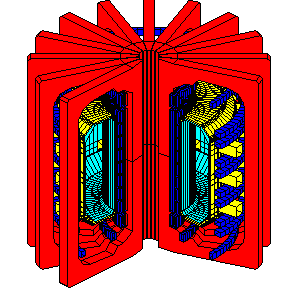

Other public- and private-sector R&D initiatives could, however, deliver results more quickly. “It’s time to step up the pace,” says Ambrogio Fasoli, who believes it would be beneficial to get DEMO up and running even while ITER is still ongoing (read the full interview below). “Fusion absolutely has to be a part of our long-term energy mix.”
Engineers working on EPFL’s tokamak have created bold, and sometimes surprising, plasma configurations, with names such as “snowflake” and “reverse triangulation.” They’ve also used deep reinforcement learning to control the flow of plasma, through their work with Google DeepMind. The findings of this research, published in Nature in 2022, have important implications for the development of all future tokamaks.
“We can no longer wait for one project to end before starting the next one.”
We spoke with Ambrogio Fasoli, who has been head of the Swiss Plasma Center since 2013 and who serves as a link between EPFL and its partner organizations in the ITER, DEMO, and other nuclear-fusion research projects.
You were recently named as Program manager for the EUROfusion consortium. What are your initial priorities?
My work has already begun in earnest! In July, I set out a proposal for a new roadmap – and I think I can safely say that the whole of Europe recognizes the need to step up the pace, despite the delays with ITER.
What does this mean in practice?
It means we’re going to start building the DEMO reactor while ITER is still in progress, and that we need to welcome and embrace innovative ideas at every level. With R&D programs of this size, even just the process of gaining experience and acquiring know-how is very instructive. We’ve already learned a lot in getting ITER to its present point, and we still have more to learn in the coming phases of the project. But we can start making key decisions about DEMO right now.

Ambrogio Fasoli, Associate Vice President for Research at EPFL and head of the Swiss Plasma Center (SPC)
So ITER could be abandoned altogether?
Not at all! We absolutely have to see ITER through to conclusion. And where possible, we also need to get other test reactors up and running in parallel, otherwise we risk further delays to our end goal: feeding fusion-generated power into the grid. This kind of approach isn’t new: work on ITER started while JET, EPFL’s tokamak, and other major European programs were still under way.
At this stage, we still don’t know where DEMO will be built.
Many sites have expressed an interest – and there could even be more than one DEMO! There’s been a groundswell of interest in fusion in recent years. Businesses have joined the race, with startups collectively raising more than $6 billion to build a variety of different prototypes – some potentially more viable than others. We’re currently in talks with a number of these firms. We’ve also seen some huge reactor-building projects get underway in China. These will probably be similar to DEMO in scale and approach.
There’s been a groundswell of interest in fusion in recent years.”

So the race is on again. How would you rate Europe’s chances?
Countries around the world are taking vastly different approaches. China is focused on state-backed initiatives, while the US is throwing its weight behind the private sector. As for Europe, we’re choosing to go down the path of public-private partnerships – a best-of-both-worlds approach that combines government funding with business agility. The key word here is integration – at every level, including in the geopolitical sphere. Nuclear-fusion research is a catalyst that brings nations together around a common cause. It’s long been that way. And it will remain so in the future. Europe, including Switzerland, can – and indeed should – remain at the head of the nuclear fusion race.
When do you envisage the first fusion reactor coming on line?
I’d say 20 years from now. I know that might sound like the standard response, but I genuinely believe we can complete DEMO within that kind of time frame, especially when you consider that we’ve taken a huge project like ITER so close to the finish line. In any case, that’s my goal – and I’ll be pushing hard to achieve it in my role at EUROfusion.
